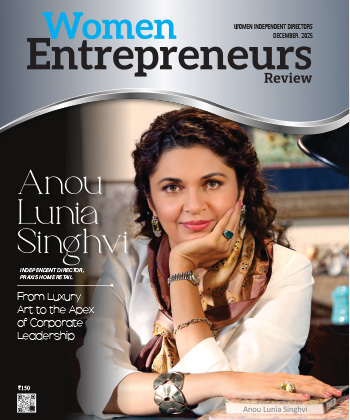
Confidence, Curiosity & Consumer-Centricity in Modern Marketing
By: Nishat Farhat, Associate Director, Cashfree Payments
Nishat Farhat is the Associate Director at Cashfree Payments, one of India’s leading B2B fintech platforms powering digital payments across the country. With a diverse and dynamic career spanning content, performance, and brand marketing, Nishat brings deep cross-functional expertise to her role.
Before joining Cashfree, she spent five impactful years at Flipkart, where she managed multiple product categories. Her earlier experiences include performance marketing at the startup Zefo and content creation at Ogilvy, giving her a well-rounded foundation in both creative and analytical domains. Nishat holds an MBA from IIM Bangalore and is a graduate of Miranda House, Delhi University.
Rooted in resilience and adaptability, Nishat speaks to the Women Entrepreneurs Review team, sharing insights on driving innovation and brand growth in the fintech space. She shares insights on consumer-centric marketing, the power of data, which is a balance of logic and magic. She also highlights the evolution of brand marketing and the importance of cross-functional skills.
To learn more about Nishat’s thoughts on excelling in marketing in today’s evolving consumer landscape, read the interview below.
How can brand marketing today adapt to the rapid shifts in today's financial markets?
Today, the market is evolving rapidly, largely due to the disruption brought in by AI. Not just the financial sector, AI is transforming industries across the board.
Globally, we are seeing a shift towards efficiency, whereas in India, while earlier it was relatively easy for companies to raise funds, many unicorns emerged based on potential alone, that’s changed. Now, investors are no longer just looking at possibilities like user growth.
They are asking tougher questions: What do your unit economics look like? When will you turn profitable? So the focus is shifting from possibility to profitability. This shift impacts marketing, too. While the customer remains at the center of everything, that hasn't changed; there’s now zero tolerance for inefficiency.
Marketing today needs to offer solid proof, real value, and be the genuine voice of the customer.
In a cluttered market where consumers have endless choices, building trust has become more important than ever. Standing out is key, but never at the cost of trust.
In an era where financial literacy is gaining traction, how can brands market complex products to women without oversimplifying or stereotyping their financial aspirations?
One specific misconception that I have noticed is that companies often assume women don't understand finance. They dumb down the communication, thinking it needs to be over simplified, which is not true. We are at a point in India where financial products are really taking off, and women are increasingly becoming financially literate.
With AI simplifying complex terms and tools, access to financial knowledge is better than ever. What brands need to do, especially if they are targeting women, is to focus on the real problem statements women face. Speak to those pain points directly.
Women today are smart, independent, and earn well, and they know that financial literacy is key to true independence. Tailor your communication, but do it with respect and relevance, not by oversimplifying.
How do you balance data-driven decision-making with creativity when crafting a brand narrative?
Marketing is a mix of logic and magic; both have to work hand in hand. The logic part is all about data. It helps us identify behaviors, spot what's not working, and understand gaps across different stages of the marketing funnel. It's critical when you are evaluating whether your campaigns are effective, what metrics to track, and where to optimize.
But data alone is not enough. That's where creativity steps in. In today's cluttered market, where consumers have endless choices and limited time, creativity is what helps you stand out. It builds emotional , speaks the customer's language, and makes your message memorable.
It's also being entertaining and giving real value, because if someone is giving you their time, it better be worth it. Data shows you what to solve, and creativity shows you how to make it resonate. Together, they are essential for solving the needs of today's financial consumer.
With digital saturation intensifying, what non-obvious signals or consumer behaviors do you monitor to build marketing campaigns that can differentiate a financial brand?
While companies regularly track NPS, Consumer sentiments analysis, C-SAT scores. you should also look at metrics like what’s your repeat rate, what’s your CAC, your brand searches, and your brand/category searches. These are some metrics which give you an understanding of overall health of your business.
Data gives you critical signals about how consumers are behaving and reacting. Since all marketing begins with the consumer at the center, staying in tune with their evolving behavior is key.
Just one round of consumer research is not enough; you need to keep going back to them regularly to understand how they are thinking, what influences their decisions, and how they view your brand versus the competition.
How can cross-functional marketing teams, assert influence over legacy-driven finance cultures and reframe brand thinking at the boardroom level?
Having worked, performance marketing, and brands, I have realized that the era of being a specialist in just one area is fading. Today, hierarchies are flattening, even in senior roles. It's not just about managing a team; you are also expected to contribute as an individual.
Having a full-funnel understanding is essential. You need to know how to run a performance campaign, build a brand strategy, and manage communication across channels. That's what builds credibility. When leaders see that you understand the entire consumer journey and the impact of each touchpoint, it sets you apart.
Moreover, brand thinking has evolved, focusing on associations people build with a brand across platforms, including influencer campaigns.
We recently ran a brand perception study and found that consumers were still linking us to a campaign from years ago
Your brand is shaped by every interaction, and to lead effectively today, you need to understand how each channel fits into that broader journey.
LAST WORD: Message for Emerging Women Leaders in Marketing
The core of good marketing always starts with the consumer, which has not changed, regardless of the business or industry. I came from a B2C background, spent years in e-commerce, worked across internet services, even hardware with Lenovo, but when I moved into B2B, I realized the fundamentals still hold. It's all about identifying the pain points of your customer or merchant. That core truth in marketing remains constant.
Women often underestimate themselves, doubting whether they are ready or capable when stepping into something new. On the contrary, many men approach the same challenges with more confidence, even if they don't have all the answers. I think that's where we need a mindset shift.
We need to back ourselves more, stay curious, ask questions, and even if we are unsure, just go for it. At the very least, it will be a learning experience. That attitude matters more than anything else. So yes, have more courage. That's the gist. You will figure it out.
Most Viewed
- 1 Women's Health Startup HerMD Closing Doors Amid Industry Challenges
- 2 5 Famous Women in Indian Armed Forces
- 3 Saudi Women No longer Require Male Permission for Clothing Choices, says Prince MbS
- 4 Kolkata Medtech Startup Innovodigm Raises Rs 5.5 Crore Seed Funding Led by IAN Group
- 5 Yamunanagar's Kashish Kalra Honoured after Securing 111th Rank in UPSC Civil Services Exam
- 6 Madurai Appoints Its First Woman Corporation Head
- 7 IAS Vijayalakshmi Bidari Appointed as the new Nagpur Divisional Commissioner
- 8 American Entrepreneur Lucy Guo Overtakes T Swift to become Youngest Female Billionaire
- 9 ICC Women's World Cup 2025 Trophy Showcased at Indore's Holkar Stadium
- 10 Aparna Saxena's Beauty Venture AntiNorm Launches in India
- 11 Vidya Nataraj Co-Founded BlueStone Jewellery & Lifestyle files IPO
- 12 5 Women Freedom Fighters of India
- 13 Dr. G Krishnapriya appointed as CEO for Trichy
- 14 M3M & Sirona Partner to Introduce Menstrual Hygiene Vending Machines in 15 Locations
- 15 Punjab Govt launches SHE Cohort 3.0 Supporting Tech-led Women Startups
- 16 Indian origin Lawyer, Sweena Pannu appointed as the US New Superior Court Judge
- 17 The Aurora Tech Award recognizes 4 Indian Women-led Startups
- 18 Kerala's Republic Day parade featured an all-female tableau
- 19 Manisha Kabbur Becomes Karnataka's First Woman International Karate Coach
- 20 Director K. S. Ravikumar's Daughter Maalica Ravikumar Launches Life Coaching Company 'Evergrowth Academy' for Women
- 21 Leezu's Raises Pre-Seed Funding to Accelerate Growth in Sexual Wellness Industry
- 22 Sattu: Super-easy summer drink for PCOS gut healing
- 23 Swathi Nelabhatla creates Sitha App, India's First Women-Exclusive Gig Platform
- 24 7 Timeless Female Kathak Dancers & their Iconic Legacies
- 25 Meet 7 Iconic Women Architects of Modern India & their Most Impactful Work
- 26 This Woman-led Insuretech Startup is Helping Bridge the Education Financing Gap in India
- 27 Women Leaders Share Lessons Learnt from India Women's WC Win
- 28 5 Enterprising Women Founders Powering Singapore's Tech & Innovation Landscape
- 29 4 Women. 4 Stories. One Vision for Smarter, Stronger Healthcare
- 30 Global Gender Gap Narrows to 68.8%, But Full Equality 123 Years Away: WEF Report 2025
- 31 Changemakers: 7 Women Entrepreneurs Taking the Make in India Movement Forward
- 32 Meet Lucy Guo, The Youngest Self-Made Female Billionaire Disrupting Tech
- 33 How Women are Driving India's Festive Online Shopping Surge






